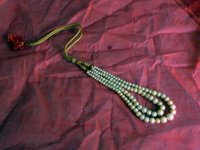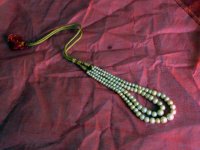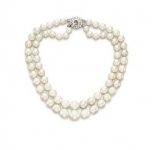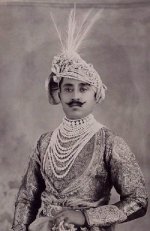You are using an out of date browser. It may not display this or other websites correctly.
You should upgrade or use an alternative browser.
You should upgrade or use an alternative browser.
Basra pearls
- Thread starter dushi23
- Start date
Caitlin
Well-known member
Can we see some closeups? That photo has hardly any luster showing. What sizes are the pearls? Is this a family piece?
Caitlin
Well-known member
Thank you.
Can you photograph on a non-reflecting white surface, such as a paper towel? If you have a macro (the flower) setting, use that, then crop.
You might also try to take some pics with outdoor indirect light- as well as in the sun.
Try to get some of the luster. That is a pretty photo, for color and composition, but not very useful for really seeing the pearls.
Thanks!
Can you photograph on a non-reflecting white surface, such as a paper towel? If you have a macro (the flower) setting, use that, then crop.
You might also try to take some pics with outdoor indirect light- as well as in the sun.
Try to get some of the luster. That is a pretty photo, for color and composition, but not very useful for really seeing the pearls.
Thanks!
lisa c
Perpetual Pearl Student
So much for Taking pictures of pearl jewellery, eh?


I cant remember the exact name of the thread, or I'd jump in more often...
I cant remember the exact name of the thread, or I'd jump in more often...
Last edited:
aspan
Member
nice double strands. Look forward to close-up pics, om a white paper towel. The threading appears to be from India/Pakistan.
Cheers
Cheers
Caitlin
Well-known member
I am getting to the point where I distrust the term, 'Basra' pearls. it really means that Indians call pearls Basra pearls. They are supposed to be pearls from Basra- which is in the persian gulf and was once a pearl trading center for India.
But Basra pearls actually from Basra are not big and they are not round. Round ones are worth fortunes, so I say get anything from India certified elsewhere.
Having said that, this particular grouping may be natural, but the large round ones are too large for Persian Gulf pearls and so the meaning of 'Basra pearls' is peculiar to India and has no standing elsewhere- except eBay.
I personally reject the term and question its use at all.
But Basra pearls actually from Basra are not big and they are not round. Round ones are worth fortunes, so I say get anything from India certified elsewhere.
Having said that, this particular grouping may be natural, but the large round ones are too large for Persian Gulf pearls and so the meaning of 'Basra pearls' is peculiar to India and has no standing elsewhere- except eBay.
I personally reject the term and question its use at all.
Sorry for the delay in photographs as i am out of station..
Well for Your information i am sharing a link, have a read and met me know weather basra pearls are round or not, and yeah one more thing they are indeed found in Basra which is a place near Iran.
http://www.imperialpearl.com/news2/pearlperspectives48.htm
And yeah i the original Baroda pearl necklace looks like the picture i attached below, they belong to royal family of baroda and thats a estate in India, they do cost a fortune and are veryyy rare.
No offence but Please do some research before posting.
Well for Your information i am sharing a link, have a read and met me know weather basra pearls are round or not, and yeah one more thing they are indeed found in Basra which is a place near Iran.
http://www.imperialpearl.com/news2/pearlperspectives48.htm
And yeah i the original Baroda pearl necklace looks like the picture i attached below, they belong to royal family of baroda and thats a estate in India, they do cost a fortune and are veryyy rare.
No offence but Please do some research before posting.
Attachments
Caitlin
Well-known member
No Offense
We have much better photos of the Baroda necklace than that from when it got resold about 5 years ago. Those two strands were high graded from a 7 strander that I think was also cherry picked from the enormous Baroda collection.
What I am saying is "Basra pearls" has become a collective term that refers to nothing and everything. It is a muddled term. Those maharajas got their great pearls from everywhere, not just Basra.
Maybe the Baroda pearls can be called Basra pearls, but that does not mean they are pinctada radiatas. What research have you done? Please provide us with any kind of opinion that the Baroda pearls are from pinctada radiatas. Their satiny sheen is far more like pearls from Pinctada maximas.
You have only to read Tavernier to realize natural pearls came from everywhere they had pearl oysters and got traded to India most of the time.
Basra was a pearl trading center equal to none- at the time. That does not mean that all the pearls that got traded out of Basra were born in the Persian Gulf. If I am wrong, please correct me with some of your research.
Besides it is just my forming opinion that I am tired of the term Basra pearls. I just now got tired of it. Maybe it was this thread. Or the other one similar with the 15mm "Basras". I have come to think it is a meaningless term. Unless you can convince me, with some research, of course, that it does have meaning.
We have much better photos of the Baroda necklace than that from when it got resold about 5 years ago. Those two strands were high graded from a 7 strander that I think was also cherry picked from the enormous Baroda collection.
What I am saying is "Basra pearls" has become a collective term that refers to nothing and everything. It is a muddled term. Those maharajas got their great pearls from everywhere, not just Basra.
Maybe the Baroda pearls can be called Basra pearls, but that does not mean they are pinctada radiatas. What research have you done? Please provide us with any kind of opinion that the Baroda pearls are from pinctada radiatas. Their satiny sheen is far more like pearls from Pinctada maximas.
You have only to read Tavernier to realize natural pearls came from everywhere they had pearl oysters and got traded to India most of the time.
Basra was a pearl trading center equal to none- at the time. That does not mean that all the pearls that got traded out of Basra were born in the Persian Gulf. If I am wrong, please correct me with some of your research.
Besides it is just my forming opinion that I am tired of the term Basra pearls. I just now got tired of it. Maybe it was this thread. Or the other one similar with the 15mm "Basras". I have come to think it is a meaningless term. Unless you can convince me, with some research, of course, that it does have meaning.
Caitlin
Well-known member
The seven strander:


The Baroda Pearls
Here's another one for the history/famous pearls file, not sure if it's been posted yet: http://www.christies.com/LotFinder/lfsearch/LotDescription.aspx?intObjectId=4890918 Perle
www.pearl-guide.com
@Caitlin
Well to support my argument that those Baroda pearls are indeed basra pearls i can let you have a chat with the "Gaikwad's" who are the rulers of the princly estate of Baroda and now when you say "how does they know what is basra and how does they differentiate from Pinctada maximas" than my dear friend its there opinion and when you are talking about a period of more than 150-200 odd years, the opinion does matter and so is the high price which these beauties demands.
I am not a pearl scientist nor have that much knowledge about pearls weather they are natural or cultural, south sea or basra but yeah with the amount of pearls i have saw in personal through these maharajas collections (nd the collection is just fantastic and nothing comes even close to what i saw in whole of your forums) i will still term them all as BASRA just because the lustre, shapes etc are very much identical to each other and for the fact is veryyy simillar to what the Baroda's pearls are.
Well to support my argument that those Baroda pearls are indeed basra pearls i can let you have a chat with the "Gaikwad's" who are the rulers of the princly estate of Baroda and now when you say "how does they know what is basra and how does they differentiate from Pinctada maximas" than my dear friend its there opinion and when you are talking about a period of more than 150-200 odd years, the opinion does matter and so is the high price which these beauties demands.
I am not a pearl scientist nor have that much knowledge about pearls weather they are natural or cultural, south sea or basra but yeah with the amount of pearls i have saw in personal through these maharajas collections (nd the collection is just fantastic and nothing comes even close to what i saw in whole of your forums) i will still term them all as BASRA just because the lustre, shapes etc are very much identical to each other and for the fact is veryyy simillar to what the Baroda's pearls are.
Caitlin
Well-known member
Call them what you like.
I am not trying to convince you of anything. I am expressing my opinion.
You just proved my point.
It appears to me that as reliably as cultured pearls that go through Japan go through maeshori as well, so do all sea pearls that go to India end up being called "Basra pearls" and their place of origin before that, is henceforth forgotten.
I think the Baroda pearls look like ducks and quack like ducks, so I can't be far wrong by calling them ducks.
I dare say most of the New World pearls probably ended up in India, because historically, India has collected natural pearls from every source they can for hundreds of years if not thousands. India collectively really makes out whenever the fleeing royals de jour have to sell their pearls. Once pearls get to India, it is hard for them to leave again and most do not. The Barodas left under extraordinary circumstances and I would not be surprised if someone with big bucks in India didn't buy them back- A mere 7+ million dollars would be a bargain to get them back.
If you think pearls all look alike after seeing so many of them, there is no hope for you having a career as a pearl sorter- I am joking with you because there is no such career except in China with freshwater pearls....
By the way- do you know of any families with elephant pearls?
I am not trying to convince you of anything. I am expressing my opinion.
You just proved my point.
It appears to me that as reliably as cultured pearls that go through Japan go through maeshori as well, so do all sea pearls that go to India end up being called "Basra pearls" and their place of origin before that, is henceforth forgotten.
I think the Baroda pearls look like ducks and quack like ducks, so I can't be far wrong by calling them ducks.
I dare say most of the New World pearls probably ended up in India, because historically, India has collected natural pearls from every source they can for hundreds of years if not thousands. India collectively really makes out whenever the fleeing royals de jour have to sell their pearls. Once pearls get to India, it is hard for them to leave again and most do not. The Barodas left under extraordinary circumstances and I would not be surprised if someone with big bucks in India didn't buy them back- A mere 7+ million dollars would be a bargain to get them back.
If you think pearls all look alike after seeing so many of them, there is no hope for you having a career as a pearl sorter- I am joking with you because there is no such career except in China with freshwater pearls....
By the way- do you know of any families with elephant pearls?
I never said that all pearls look alike, i just said that most of the pearls i saw in those princely estates are more or like same in there lustres,shapes etc. and thats the reason why we here in India call them as "Basra" pearls.
Now if you question the authenticity of Christie/sothby's etc buying them and selling them telling as Natural Basra pearls than its your opinion.
Yeah saw a couple of them which in local terms are known as "gajamukta"..But dying to see a gajamani (a 108 piece necklance of gajamukta) !! Hope you will provide a pic of the same
Now if you question the authenticity of Christie/sothby's etc buying them and selling them telling as Natural Basra pearls than its your opinion.
Yeah saw a couple of them which in local terms are known as "gajamukta"..But dying to see a gajamani (a 108 piece necklance of gajamukta) !! Hope you will provide a pic of the same
Caitlin
Well-known member
OK. Let's get picky. You said "very much identical". You can't get more identical than identical and "very much" just adds to the the emphasis on identical. But maybe that is a language thing and Identical doesn't mean identical to you.
Just because I no longer like the term "Basra Pearl" does not mean I am trying to convince anyone else, esp. you. In india, it seems to me- please correct me if I am wrong, that many things are termed "pearls" thus there is a second identifier as to what kind of pearls. Sea pearls seem to be called Basra pearls as opposed to say, elephant pearls, or tree pearls or cloud pearls or whatever. Elephant pearls are not pearls in English at all. "Pearls" means something that comes from a mollusk, nothing more. Cultured pearls are currently correctly named cultured pearls, though that is changing. "Pearls" means any kind of natural mollusk pearls. When we add qualifiers they are Freshwater pearls or sea pearls to tell those two apart. But that is not enough for most people here. Pearls are usually broken into types, thus we have akoya pearls, Tahitian pearl, South Sea Pearls depending on type or where they originated. (Akoya is actually the name of the oyster, not a place name)
In order to identigy the true origin of a mollusk pearl, we could call pearls from the Persian Gulf by their scientific names. Thus, Persian Gulf pearls would be called P. Radiatas, those from Tahiti, P. Margaretifera, south sea pearls are actually from Pinctada Maxima mollusks. And so on.
All I have said here is that once a pearl gets to India, the mollusk origin or place of origin is swallowed up in the generic term "Basra", which in turn has come to mean - NOT only pearls from Basra, but all natural pearls, regardless of their place of origin of the type of mollusk in which they grwe.
You are defending a pointless piece of verbal real estate , in my opinion. Go ahead and call any pearls you want Basra pearls. All you are really saying is you adhere to a cultural or verbal tradition from India and reject any other term for a pearl that has moved to India.
Why don't you read Tavernier before you scold me any further? http://www.amazon.com/Travels-India...d=1349201946&sr=8-1&keywords=tavernier+pearls
Once a natural sea pearl gets to India, it becomes a Basra pearl and the actual point of origin is ignored, if different. Ignored to the point that some people actually think all pearls in India came from Basra, if they are natural.
If the owner of a set of pearls calls them Basra, then Christies does too, but Christies et al do not limit themselves to the term Basra. They also use the name of the place of origin or type of pearl, ie akoya, Tahitian, South Sea, depending on what they are told.
Just because I no longer like the term "Basra Pearl" does not mean I am trying to convince anyone else, esp. you. In india, it seems to me- please correct me if I am wrong, that many things are termed "pearls" thus there is a second identifier as to what kind of pearls. Sea pearls seem to be called Basra pearls as opposed to say, elephant pearls, or tree pearls or cloud pearls or whatever. Elephant pearls are not pearls in English at all. "Pearls" means something that comes from a mollusk, nothing more. Cultured pearls are currently correctly named cultured pearls, though that is changing. "Pearls" means any kind of natural mollusk pearls. When we add qualifiers they are Freshwater pearls or sea pearls to tell those two apart. But that is not enough for most people here. Pearls are usually broken into types, thus we have akoya pearls, Tahitian pearl, South Sea Pearls depending on type or where they originated. (Akoya is actually the name of the oyster, not a place name)
In order to identigy the true origin of a mollusk pearl, we could call pearls from the Persian Gulf by their scientific names. Thus, Persian Gulf pearls would be called P. Radiatas, those from Tahiti, P. Margaretifera, south sea pearls are actually from Pinctada Maxima mollusks. And so on.
All I have said here is that once a pearl gets to India, the mollusk origin or place of origin is swallowed up in the generic term "Basra", which in turn has come to mean - NOT only pearls from Basra, but all natural pearls, regardless of their place of origin of the type of mollusk in which they grwe.
You are defending a pointless piece of verbal real estate , in my opinion. Go ahead and call any pearls you want Basra pearls. All you are really saying is you adhere to a cultural or verbal tradition from India and reject any other term for a pearl that has moved to India.
Why don't you read Tavernier before you scold me any further? http://www.amazon.com/Travels-India...d=1349201946&sr=8-1&keywords=tavernier+pearls
Once a natural sea pearl gets to India, it becomes a Basra pearl and the actual point of origin is ignored, if different. Ignored to the point that some people actually think all pearls in India came from Basra, if they are natural.
If the owner of a set of pearls calls them Basra, then Christies does too, but Christies et al do not limit themselves to the term Basra. They also use the name of the place of origin or type of pearl, ie akoya, Tahitian, South Sea, depending on what they are told.
That was heavy..Well with all those arguments, discussions etc i am no authority to say weather it is basra or just another natural pearl. But yeah i just posted the pic of the necklace i possess coz for me it looks something different and is very dear to me.
Now you hold your scientific side and i hold my so called traditional side.
For those "Elephant pearls" well leave it coz you won't believe it and i am in no mood to waste my energy on it.
Nyways thanks for those remarks,leaving with a pic,hope it will lighten up your mood.
Tk care
Now you hold your scientific side and i hold my so called traditional side.
For those "Elephant pearls" well leave it coz you won't believe it and i am in no mood to waste my energy on it.
Nyways thanks for those remarks,leaving with a pic,hope it will lighten up your mood.
Tk care
Attachments
GemGeek
Pearlista
Honestly, Basra has become a name that has been applied generically to natural pearls. So rare was a fine round natural pearl, that any type of pearl that matched, was used. This has been proven by laboratory testing. Many famous strands have pearls from more than one mollusk and saltwater strands often have a freshwater or two because the matching was so difficult. India is a country that appreciates and celebrates pearls - that is for sure. 
Amanda
Member
- Joined
- Jan 25, 2012
- Messages
- 521
OK. Let's get picky. You said "very much identical". You can't get more identical than identical and "very much" just adds to the the emphasis on identical. But maybe that is a language thing and Identical doesn't mean identical to you.
to be fair, Caitlin, I'm sure I've seen you talking about "very unique" which is a similar thing - something is unique, or it's not unique, rather like identical.
Caitlin
Well-known member
LOL! I should get scolded for saying 'very unique'! My English professor father would have corrected me immediately, had he heard that!!
I figured he knew what I was talking about. I forgot to explain it for others who aren't reading every word. Post #8 he said, "i will still term them all as BASRA just because the lustre, shapes etc are very much identical to each other.
Post #15 he said, "I never said that all pearls look alike, i just said that most of the pearls i saw in those princely estates are more or like same in there lustres,shapes etc."
That is what I was referring to- a contradiction in his own posts and thus a semi-definition of "Identical".
I just now noticed he also said in #8 "Now if you question the authenticity of Christie/sothby's etc buying them and selling them telling as Natural Basra pearls than its your opinion."
I thought I was just saying I personally don't like the term Basra, but wasn't trying to convince anyone else, just express my opinion about the term. I don't care who uses it. So at that point it turned into a debate from me just expressing my opinion. I made it clear it was my opinion.
I much prefer it when people get to express their own opinion without argument, then each can express a opinion without a debate stating up by arguing with another opinion. Also asking questions to clarify another's position seems fair . I now think there was much more of a language issue than I thought to begin with.
To make it clear, this is my brand newly formed opinion:
I no longer like the term "Basra pearls" unless people realize that not all natural pearls come from Basra.
Basra pearls is now a generic term like Kleenex, that means a natural pearl. Any natural pearl. Not just ones from the Persian Gulf port of Basra. But people also take that word literally- as dushi did - and believe all those pearls in India came out of the Persian gulf, therefore they didn't come from elsewhere, therefore they feel they need to defend against my perceived attack on the authenticity of Basra pearls.
Dushi appears to firmly believe that all Basra pearls came from Basra and can't entertain the thought that the term might also include South Sea pearls, and that the Baroda pearls can't be Basra pearls and South Sea pearls (for instance) at the same time, so only the term Basra pearls is correct.
I now think that between his command of English and of knowledge about pearls, I was talking way over his ability to figure out what I said.
If I forget this in the future, I don't mind if some one reminds me.
I figured he knew what I was talking about. I forgot to explain it for others who aren't reading every word. Post #8 he said, "i will still term them all as BASRA just because the lustre, shapes etc are very much identical to each other.
Post #15 he said, "I never said that all pearls look alike, i just said that most of the pearls i saw in those princely estates are more or like same in there lustres,shapes etc."
That is what I was referring to- a contradiction in his own posts and thus a semi-definition of "Identical".
I just now noticed he also said in #8 "Now if you question the authenticity of Christie/sothby's etc buying them and selling them telling as Natural Basra pearls than its your opinion."
I thought I was just saying I personally don't like the term Basra, but wasn't trying to convince anyone else, just express my opinion about the term. I don't care who uses it. So at that point it turned into a debate from me just expressing my opinion. I made it clear it was my opinion.
I much prefer it when people get to express their own opinion without argument, then each can express a opinion without a debate stating up by arguing with another opinion. Also asking questions to clarify another's position seems fair . I now think there was much more of a language issue than I thought to begin with.
To make it clear, this is my brand newly formed opinion:
I no longer like the term "Basra pearls" unless people realize that not all natural pearls come from Basra.
Basra pearls is now a generic term like Kleenex, that means a natural pearl. Any natural pearl. Not just ones from the Persian Gulf port of Basra. But people also take that word literally- as dushi did - and believe all those pearls in India came out of the Persian gulf, therefore they didn't come from elsewhere, therefore they feel they need to defend against my perceived attack on the authenticity of Basra pearls.
Dushi appears to firmly believe that all Basra pearls came from Basra and can't entertain the thought that the term might also include South Sea pearls, and that the Baroda pearls can't be Basra pearls and South Sea pearls (for instance) at the same time, so only the term Basra pearls is correct.
I now think that between his command of English and of knowledge about pearls, I was talking way over his ability to figure out what I said.
If I forget this in the future, I don't mind if some one reminds me.
Similar threads
- Replies
- 7
- Views
- 465




